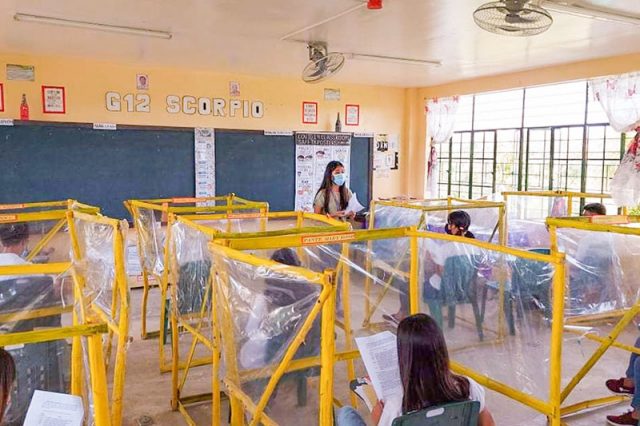
A distinguished professor of chemistry from the University of Colorado Boulder added the Philippines’ practice of using glass or plastic barriers in schools under the “COVID-19 Hall of Shame.”
Last December, Jose-Luis Jimenez, an institute fellow at the Cooperative Institute for Research in Environmental Sciences, created a Twitter thread where he compiled “evidence” of how governments and organizations protect their citizens.
This was his response to the remarks of the World Health Organization‘s COVID-19 Technical Lead Maria Van Kerkhove, who admitted that she has avoided saying that the coronavirus is airborne.
“I think that decision by @WHO is one of the LARGEST ERRORS IN THE HISTORY OF PUBLIC HEALTH,” Jimenez tweeted.
He then compiled policies and measures of some government bodies and organizations against the COVID-19.
His 116th thread focused on the Philippines where he cited that some schools use glass or plastic barriers in students’ desks as supposed preventive measures against the virus.
“Extensive use of lateral plexiglas (perspex) barriers in schools. They INCREASE transmission. Trap virus-laden air (and) make ventilation more difficult,” Jimenez wrote.
“@DOHgovph stuck on droplets, doesn’t understand #COVIDisAirborne,” he added, tagging account of the the country’s Department of Health.
116/ PHILIPPINES🇵🇭: extensive use of lateral plexiglas (perspex) barriers in schools. They INCREASE transmission (@ScienceMagazine, https://t.co/pSBR9KLk6W). Trap virus-laden air & make ventilation more difficult. @DOHgovph stuck on droplets, doesn't understand #COVIDisAirborne pic.twitter.com/Rb9Mg1R7xY
— Prof. Jose-Luis Jimenez (@jljcolorado) January 5, 2022
Jimenez’s tweet was noticed by some Filipinos who commented that the supposed COVID-19 preventive measure was “embarrassing.”
“Imagine getting recognized for doing what you’re NOT supposed to do,” another Twitter user said.
“Nakakahiya na naman po ang ating gobyerno. Sikat na naman sa international community,” wrote a different Filipino.
He then tagged this practice in physical classroom setups under “World #COVIDHallofShame of worst practices” against COVID-19.
“I’ve had to add the Philippine schools to the World #COVIDHallofShame of the worst practices to fight COVID transmission,” Jimenez said in a quote tweet of his post.
“COVID is Airborne, @WHO says it clearly now,” he added, linking a WHO webpage on COVID-19 Q&A where it mentioned that the virus can be transmitted through aerosol or airborne transmission.
I've had to add the Philippine schools to the World #COVIDHallofShame of the worst practices to fight COVID transmission
COVID is Airborne, @WHO says it clearly now: https://t.co/tfehpqhUVa
Please start to follow Science: https://t.co/bl7lK8RH0ehttps://t.co/Pw2woYWFB9 pic.twitter.com/xMymLhndQA
— Prof. Jose-Luis Jimenez (@jljcolorado) January 5, 2022
In the Philippines, face-to-face classes have been called off in areas under Alert Level 3 of the country’s COVID-19 Alert Level System.
This includes Metro Manila and some areas in the NCR Plus, namely Bulacan, Cavite, Laguna and Rizal.
The government previously elevated these areas’ alert level due to the rising coronavirus cases. These curbs will stay until January 15.
Prior to the postponement, some schools have returned to limited physical classes after more than a year of distance learning due to the prevailing pandemic.
But pictures of their classroom setups with glass or plastic barriers surrounding students’ desks that previously circulated online failed to impress some Filipinos.
ALSO READ: Isko Moreno told: Prioritize airflow over barriers in classrooms as classes start
Many suggested improved ventilation instead as they emphasized that the coronavirus can also be transmitted through aerosol particles. These are produced when people breathe, talk, sing, speak, exercise, cough and sneeze.
RELATED: Ventilation over plastic barriers: Suggestions as limited onsite classes resume
These particles can remain suspended in the air for hours in poorly ventilated and enclosed spaces.
A 2021 report by the New York Times had argued that plastic barriers “do little to stop the spread of the coronavirus.”
It said that under normal conditions, exhaled breath particles in classrooms, stores and offices disperse, get carried by air currents and then get replaced by fresh air around every 15 to 20 minutes, depending on the ventilation system.
The report said that installing plastic barriers can change the airflow in a room, disrupt normal ventilation and create “dead zones” where viral aerosol particles can build up and become highly concentrated.
“If you have a forest of barriers in a classroom, it’s going to interfere with proper ventilation of that room,” Linsey Marr, professor of civil and environmental engineering at Virginia Tech, was quoted as saying before.
“Everybody’s aerosols are going to be trapped and stuck there and building up, and they will end up spreading beyond your own desk,” she added.
A 2021 study conducted by the Ateneo de Manila University also found out that having lesser plastic barriers in public transportation reduces COVID-19 transmission.
“The study team also stressed the importance of wearing face masks that perfectly fit the face, instead of using barriers of any form that may also trap viral loads of SARS-CoV-2,” noted a report that cited the study.
Last November, Education Assistant Secretary Malcolm Garma said that setting up plastic barriers in face-to-face classes was not required.
“Kung may nakalagay, hayaan natin, pero kung wala, hindi na natin in-e-encourage ito,” he was quoted as saying before.
Health Undersecretary Maria Rosario Vergeire earlier said that physical classes can be safe even without the installment of the barriers.
“As long as we can comply with the physical distancing, adequate ventilation and symptomatic screening across the different school children and teaching and non-teaching personnel, ay maaari tayong makapagsiguro ng kaligtasan ng ating mga kabataan,” she said in the same month.









